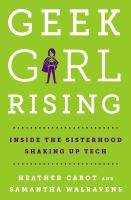Book Review: Geek Girl Rising
Monday, September 24th, 2018Cabot, Heather. Geek girl rising : inside the sisterhood shaking up tech. St. Martin’s Press, 2017.
 The book Geek Girl Rising by journalists Heather Cabot and Samantha Walravens should be required reading for anyone interested in entering a white, male dominated STEM field. This book covers the history of women in technology or engineering fields, and in business in general, making pivotal points about the lack of diversity in the technology sector; the importance of women helping other women succeed; and the importance of metrics in effecting change.
The book Geek Girl Rising by journalists Heather Cabot and Samantha Walravens should be required reading for anyone interested in entering a white, male dominated STEM field. This book covers the history of women in technology or engineering fields, and in business in general, making pivotal points about the lack of diversity in the technology sector; the importance of women helping other women succeed; and the importance of metrics in effecting change.
After a discussion about the need for diversity in STEM companies, the authors discuss ways to advocate for change. The first step to change is learning the actual ratios of women and individuals of color vs white males across industries, facts that tech companies seemed determined to hide. In a lawsuit in 2008, five of the largest Silicon Valley companies, including Google, won a lawsuit that had their company employee makeup declared a “trade secret.” This was reversed around 2013-2014 when the lack of diversity in these companies gained mainstream public attention through popular campaigns like #ChangetheRatio, as well as harassment claims and other lawsuits. People became interested in making a difference, both in reporting the numbers in their workplaces and in using consumer power to incentivize companies to change.
One factor contributing to the lack of diversity in engineering and technology fields is a lack of positive role models and success stories, despite the number of women with power and influence in these industries. Media outlets fail to promote and encourage women, who often face difficult or painful work situations, leading them to leave the industry or to avoid the spotlight as it attracts negative attention. Women pioneers in tech are not cited in articles or books as if their contributions are un-noteworthy. Ultimately, this lack of visibility corresponds to a lack of access and opportunities for growth as well as an inability to inspire others. To counter, Geek Girl Rising exhibits inspirational stories from a multitude of women from a wide range of companies and industries with pithy bios, interviews, anecdotes, and upbeat newsy briefs.
To combat this lack of diversity in key industries, Cabot and Walravens recommend several solutions. First, bring the problems of working in a male dominated work place to light using metrics; for example, the recent media stories about issues at Google and Facebook. A second solution is to “ignite the next generation.” President Obama’s 2014 STEM incentives encourage children, especially girls and children of color, to enter fields involved in innovation. The authors also begin and end their book referencing one female entrepreneur, Debbie Sterling, who in 2014 came out with GoldieBlox, a building/engineering/puzzle game focused around storytelling and problem-solving for children, which was sold by Toys R Us and exhibited at the toy expo in New York’s Jacob Javits Center.
This book is also available as an audiobook on OverDrive.
© Amy Brennan & Ford Library – Fuqua School of Business.
All rights reserved.
 Stephens-Davidowitz, Seth.
Stephens-Davidowitz, Seth.  Pinker, Steven.
Pinker, Steven.  Pink, Daniel H.
Pink, Daniel H.  Peterson, Jordan B.
Peterson, Jordan B.  Coyle, Daniel.
Coyle, Daniel.  Carreyrou, John.
Carreyrou, John.  Eyal, Nir.
Eyal, Nir.  Rubin, Gretchen.
Rubin, Gretchen.  Tegmark, Max.
Tegmark, Max.  Taleb, Nassim Nicholas.
Taleb, Nassim Nicholas.  An American Sickness: How Healthcare Became Big Business and How You Can Take It Back by Elisabeth Rosenthal is a sobering look at the history and current state of the American healthcare system. Rosenthal, a journalist and former physician, paints a bleak picture, but her accessible style and systematic organization make the book an engaging read.
An American Sickness: How Healthcare Became Big Business and How You Can Take It Back by Elisabeth Rosenthal is a sobering look at the history and current state of the American healthcare system. Rosenthal, a journalist and former physician, paints a bleak picture, but her accessible style and systematic organization make the book an engaging read. Junger, Sebastian.
Junger, Sebastian.  Dean, Will.
Dean, Will.  Ferris, Timothy.
Ferris, Timothy.  Never Split the Difference: Negotiating as if Your Life Depended on It (2016) by Chris Voss with Tahl Raz explores a wealth of negotiating techniques presented in a framework of topical chapters that are meant to build on and to inform one another.
Never Split the Difference: Negotiating as if Your Life Depended on It (2016) by Chris Voss with Tahl Raz explores a wealth of negotiating techniques presented in a framework of topical chapters that are meant to build on and to inform one another.  Blue Ocean Shift (2017) by W. Chan Kim and Renee Mauborgne is the follow-up volume to the bestselling Blue Ocean Strategy (2005), which presented the theory that businesses could successfully create both new markets and innovative products simultaneously in highly competitive spaces. In their new book, the authors provide a process for creating and executing the strategy. The first section of the book summarizes blue ocean strategy, emphasizing its distinctiveness and its value, while the second section presents five steps for making a blue ocean shift.
Blue Ocean Shift (2017) by W. Chan Kim and Renee Mauborgne is the follow-up volume to the bestselling Blue Ocean Strategy (2005), which presented the theory that businesses could successfully create both new markets and innovative products simultaneously in highly competitive spaces. In their new book, the authors provide a process for creating and executing the strategy. The first section of the book summarizes blue ocean strategy, emphasizing its distinctiveness and its value, while the second section presents five steps for making a blue ocean shift. Business columnist at the New Yorker James Surowiecki recommends
Business columnist at the New Yorker James Surowiecki recommends  Corporate strategy advisor Ken Favaro nominates
Corporate strategy advisor Ken Favaro nominates  Bethany McLean, contributing editor at Vanity Fair, commends
Bethany McLean, contributing editor at Vanity Fair, commends  Leadership development consultant and speaker Sally Helgesen nominates
Leadership development consultant and speaker Sally Helgesen nominates  At The Economist Ryan Avent calls
At The Economist Ryan Avent calls  Media thought leader Catharine P. Taylor recommends
Media thought leader Catharine P. Taylor recommends  Duff McDonald, author of the HBS critique
Duff McDonald, author of the HBS critique  Mike Krzyzewski, who has won more games than any basketball coach in the history of the NCAA Division I, once wrote that while talent and coaching are essential, the secret to greatness is something else: “The single most important ingredient after you get the talent is internal leadership. It’s not the coaches as much as one single person or people on the team who set higher standards than that team would normally set for itself.”
Mike Krzyzewski, who has won more games than any basketball coach in the history of the NCAA Division I, once wrote that while talent and coaching are essential, the secret to greatness is something else: “The single most important ingredient after you get the talent is internal leadership. It’s not the coaches as much as one single person or people on the team who set higher standards than that team would normally set for itself.” Christensen, Clayton M., et al.
Christensen, Clayton M., et al.  Grosz, Stephen.
Grosz, Stephen.  Brafman, Ori, et al.
Brafman, Ori, et al.  Tavris, Carol, et al.
Tavris, Carol, et al.